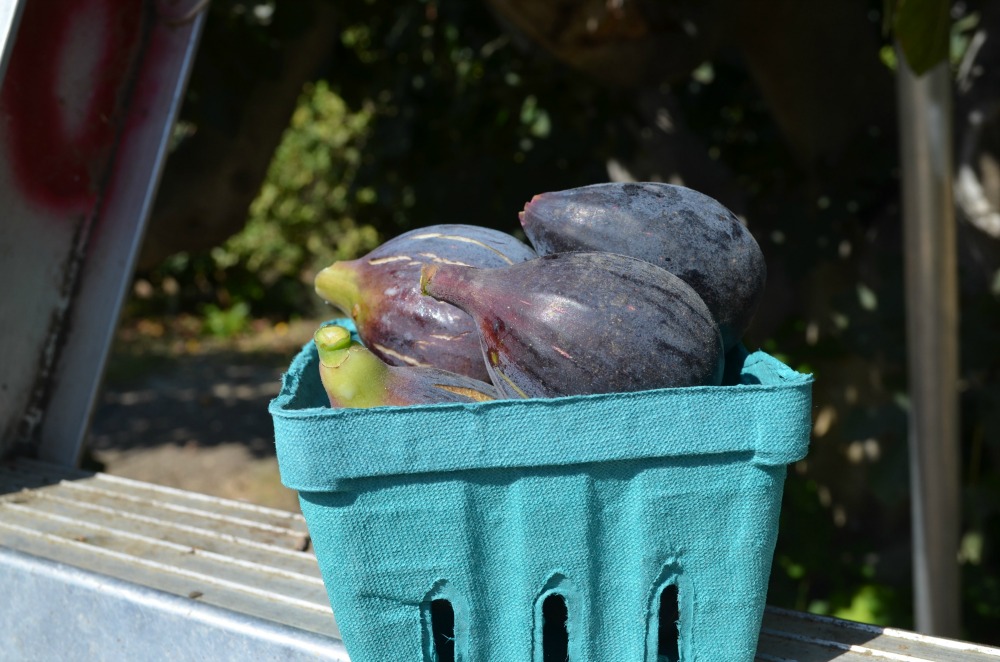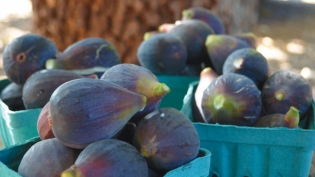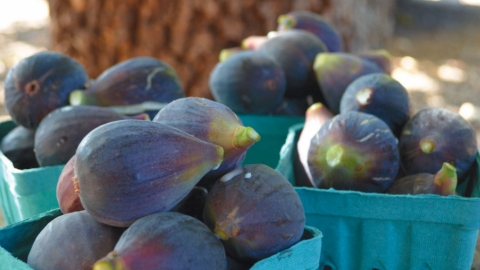The Perfect Fig?
I grew up surrounded by wonderful produce – a Sicilian birthright of basil, tomatoes, blood oranges, grapes, melons, and finocchio, to name only a few. The harvests defined the seasons, and mornings were spent eagerly searching our gardens for the most promising items of each variety. All crops were cherished; however, there was one particular fruit that created special anticipation when ripe–an unpredictable prize that sometimes has just the right combination of sweetness, texture, and flavor to make it unforgettable. I’m talking about the elusive perfect fig.
Inevitably, most of the figs we ate were rather ordinary, and accepted as such, like common table wine. But with figs, there is always the potential to exceed one’s expectations, and to do so to an unimaginable degree. There is no rating system to identify the ideal fig. You just know it when it happens, mainly because you can’t imagine any fruit tasting better than what is now in your mouth.
To secure the best fruit, many of our family and friends nurtured their version of the most treasured fig tree. These were heirlooms, and during visits I listened with youthful wonder to each owner’s story of how this one unmatched variety came into their possession. Sometimes, if I said the right things and showed the proper interest, I was given cuttings to take home and grow for myself. In this manner (and from some covert snippings), I developed a small collection of fig trees.
When my daughter was very young we would forage these then-shoulder-high trees, searching for the best figs. I’d find a promising fruit, split it open for her, and ask, “How is it?” She often answered, “Good, but not great,” implying it wasn’t perfect. This, more than anything else, inspired me to keep seeking out better selections.
Years later, our fig collection continues to develop, and with kind help from the National Clonal Germplasm Repository at UC Davis, we now grow about 75 distinct varieties. Of course, not all of them are well suited to our farm in Meiners Oaks, but there have been a few consistent standouts. Almost every variety we grow has some good figs each year, but we want to experience the selections that bear baskets of sweet, succulent fruit – or even better, can produce the perfect fig.
Finding the best candidates requires some effort – there are several edible fig classes, with hundreds of varieties to choose from. The most familiar figs in our area are classed as “Persistent.” These common figs, which include the Mission, Brown Turkey, Genoa, and many others, do not need pollination to set fruit. Another group of figs is known as “Smyrna,” with the most familiar variety in California being the Calimyrna. Smyrna figs require pollination from an inedible caprifig (so named because only goats will eat them). We grow a few caprifigs to help our Smyrna varieties set fruit, with pollination provided by the female fig wasp. And then there is the “San Pedro” class of figs, which includes the King variety. San Pedros are an intermediate group, with their first fruit set in spring (called the breba crop) being self-fertile, and the main crop in summer requiring pollination.
To get the sweetest figs, you must ripen them fully on the tree. There is an old proverb on how to select a ripe fig: If it has a hangman’s neck (droops at the stem), a mourner’s eye (honeydew oozing from the eye at the bottom of the fruit), and a penitent’s robe (skin tears and cracks), it’s ready. Regrettably, many figs don’t follow this rule. I try to wait until the fruit is soft, somewhat droopy at the neck, and does not exude milky latex when picked.
Choosing my favorite figs is never easy. Some varieties do well one year, then poorly the next. Others will taste great, but have open eyes that make them fodder for dried fruit beetles. And sometimes, out of nowhere, a mediocre variety will produce a few spectacular figs. I think this is what makes growing the different figs so enjoyable – foraging, but never knowing when that perfect fig will appear, and then finding the one that almost drops me to my knees.
Here are my choices for the varieties that produce the best quality figs for us, and are most likely to produce truly exceptional fruit:
Adriatic: With green skin and red flesh, Adriatic is often called a strawberry fig. One October evening I was walking the orchard when I came upon some of the best figs I’ve ever eaten – from our Adriatic and “Ojai Straw” trees (I think both varieties are probably Adriatic). It was nearly a religious experience. Col de Dame, another green fig with incredibly deep red flesh, is also magnificent.
Bournabat: A large, luscious fig with pink, fleshy pulp. Bournabat has the most interesting texture in your mouth – like a stringy marshmallow, only better.
Flanders: A violet-skinned fruit with pink-amber flesh. Flanders has reliable yields of very sweet figs almost all summer. For consistently good figs, it’s hard to improve on this one.
King: A San Pedro fig that has a wonderful, sweet breba crop. These figs follow the ripeness proverb to a T, and a branch of drooping, weeping Kings is a beautiful site in early summer.
Marabout: A light red fig, with a good summer crop that droops, cracks, and weeps on cue when ripe. Marabout is a choice Smyrna fig. To ensure pollination, I placed several caprifigs judiciously close to our Marabout trees.
Panachee: A beautiful fig with green and white stripes, reminiscent of a hot air balloon. Inside, the flesh is deep red. Our Panachee figs are ready in September, and have no spring breba crop. When they first start to ripen, the flesh is somewhat dry and has a pronounced citrus quality (think Tarocco blood orange). As it softens on the tree, the flesh turns to jam, and develops a wonderful strawberry orange flavor. Panachee figs have thick skin, a tight eye, and hang well on the tree. For flavor, appearance, and resistance to the elements, Panachee is my overall favorite.
Tena: I love this fig for its refreshing, lightly sweet flavor. The flesh of a Tena is moist, but not heavy, and is light pink or amber. When really ripe (late summer), you can almost drink it. I have several Tena figs scattered about our farm just so I can snack on them without returning to the main fig orchard.
UCR 278-128: A large, sweet, yellow fig that deserves a better name than it has now. UCR 278-128 is my son’s favorite, and he will go straight to this tree before searching the others. The late summer crop is much better, and is more resistant to the dried fruit beetle, than the early breba harvest. This fig is similar to another yellow variety, Deanna.
Violette: Also known as Violette de Bordeaux, this fig is small, deep violet in color, and has an intense strawberry jam flavor. Even the tree is petite, which makes it a great choice for a pot in a sunny patio.
143-36: I include this yet-unnamed variety, as it is the most promising fig I’ve planted recently. The 143-36 has a nice sugar-acid balance, and the red flesh under a green skin tastes to me like a ripe Laroda plum. This fig has a closed eye, it droops to let you know when it is ripe, and sets a good late summer main crop. Our 143-36 trees are only two years old, and already one of my favorites.
I’m willing to bet that most of us have never tasted a truly amazing fig – perhaps this is why some people don’t even like them! For the best fruit, you will either need to raise your own, or get them fresh off the tree from the grower. It’s the only way of hoping to find the perfect fig.







